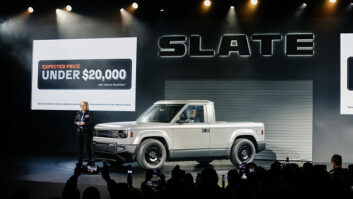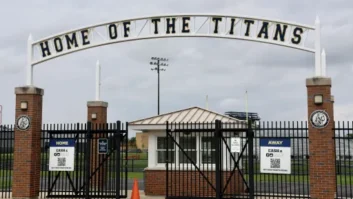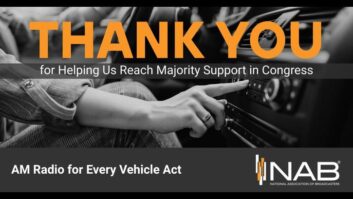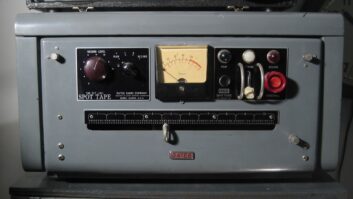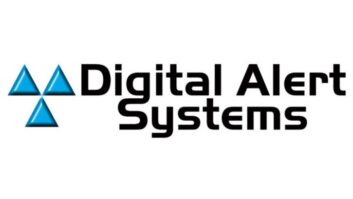CHICAGO — Internet radio’s future role is a large question on the minds of broadcast managers these days, judging from discussion at the fall Radio Show.
EAS, low-power issues and chips in smartphones continue to be hot-button points.
Attendance picked up at the event. NAB and RAB put the number at 2,206, compared to 1,785 last year. Though a service workers’ union picketed outside the main conference hotel, the radio event was not disrupted.
Next year’s show is Sept. 19–21 in Dallas at the Hilton Anatole.
A sampling of news from the event:
Streaming Is Important, Though the Model Is Flawed
Radio executives may differ about how much a part of their portfolio streaming should be; but all seem to acknowledge the Web as an important part of their future.
Group heads from CBS Radio, Entercom, Cumulus and Hubbard Radio discussed Internet radio issues in the Leadership Breakfast.
“Is Pandora’s business model good? Yes,” said CBS Radio President/CEO Dan Mason. But, he continued, soon every radio operator “will have the opportunity to do the same kind of personalized” services, as more group owners decide to stream, or personalize its offerings.
Mason stressed that streaming is part of a healthy cash flow at CBS. However, he said, CBS entity Last.FM, its online radio and social-networking site, “is part of what we do. It’s not the big picture.”
The streaming business model is expensive compared to broadcasting’s one-to-many model, said Hubbard Radio President/CEO Bruce Reese. He noted that as streaming consumption expands, operational costs go up, whereas broadcasting costs remain the same regardless of the number of listeners.
“Until that changes, we won’t get a good business model; but we do it and try to make the product sound great,” said Reese.
He complimented the personalized audio channels that CBS Radio and Clear Channel Radio offer. Overall, Reese sees a lot of experimentation but doesn’t see streaming bringing significant revenue for radio.
Westergren: Ad Dollars Start to Leave Broadcast For Internet Radio
Executives spent lots of time discussing Internet radio after Pandora Founder/CEO Tim Westergren declared that the future of radio is Internet “radio.”

Pandora Media founder and Chief Strategy Officer Tim Westergren says local ad dollars are beginning to leave traditional radio for Internet radio. Photo by Leslie Stimson
Speaking at the Radio and Internet Newsletter Summit on the eve of the convention, Westergren said Pandora is seeing the beginning of a shift in advertising dollars as money migrates from traditional broadcast to Pandora’s personalized music experience. In other words, Web radio is now part of the local radio ad buy in markets like Duluth, Minn., and Waukegan, Ill., to name a couple he mentioned.
“We’re seeing car dealerships starting to buy Pandora,” along with the hospitality and grocery industries, Westergren said. “Internet radio is beginning to draw advertising dollars because it’s targetable. It’s a richer experience, which leads to higher click-through rates.”
Technology is driving the change, he said, highlighting devices like Livio Radio’s Internet radio car kit, about which RW wrote about in the Oct. 5 issue.
Noting that Pandora’s sales staff is growing, Westergren reiterated his trademark statement that Pandora’s goal is “nothing less than having personalized radio on every computer, in every car, gym and home in the country.”
Clear Channel executives, however, are not convinced that Pandora or other personalized music services are going to spell the demise of over-the-air radio. The radio group launched the iPhone application for its iHeartRadio streaming music service before the show.
The latest version of iHeartRadio continues to offer streaming from some 800 local stations, but Clear Channel Radio is highlighting its new “custom stations” capability. It will draw from a library of 11 million songs, and be offered commercial-free through the end of 2011. Clear Channel Radio pointed out that its iHeartRadio has access to 10 times the songs that Pandora has.
Group Heads Tackle HD Marketing, Conversion

Leadership Breakfast panelists, from left, Entercom Communications’ David Field, Cumulus’ Lew Dickey, CBS Radio’s Dan Mason and Hubbard Radio’s Bruce Reese discuss growth opportunities. © NAB/RAB
Several industry executives believe HD Radio marketing should be improved; and they urge stations to convert to HD and to implement all its data capabilities, particularly Artist Experience, the ability to synch images with the audio.
Speaking at a breakfast with peers from CBS Radio, Entercom and Hubbard, Cumulus President/CEO Lew Dickey said HD Radio has “a bit of a marketing issue. If you ask the man on the street about HD, you would not get the answers you’d like.”
While noting that “penetration takes a long time,” Dickey said: “We’ve got to be digital, and everything is headed in that direction. Now, it’s incumbent on broadcasters to come together and make sure we have interesting interfaces in the car.”
The executives agreed with a Ford executive’s recent assessment that radio needs to convert to HD to remain relevant in the dash. Jim Buczkowski is a Henry Ford Technical Fellow and director of Electrical and Electronic Systems Research and Innovation for the car manufacturer. In a letter to the industry he said consumers have come to expect the same consistent “look and feel” from their in-car media experience as they experience with their iPods, smartphones, Internet radio and other digital technology, and he urged stations especially to implement Artist Experience.
Hubbard Radio President/CEO Bruce Reese said, “HD is our brand. This is who we are.” When drivers turn on the radio in their new Ford, “We can’t be 97.1 FM [analog] when our competitors are putting pictures and graphics up there.”
Alliance Puts Gas Pedal to AE, phone Chips
IBiquity Digital and NAB’s FASTROAD project are working on various aspects of persuading carriers and manufacturers to integrate FM HD chips in cellphones and other mobile devices, and on combining broadcast with IP to work in concert as a backchannel.
Few stations have implemented Artist Experience so far. That’s a problem, according to iBiquity, Ford and several radio group executives whose employers are part of the HD Alliance. They say more receivers are coming on the market that promise a richer visual experience.
The alliance has formed a technology task force headed by Emmis Communications Senior Vice President/Chief Technology Officer Paul Brenner, who’s also president of the Broadcast Traffic Consortium, and CBS Radio Senior Vice President of Engineering Glynn Walden. It is aimed at determining what member stations need in order to implement HD features supporting Artist Experience — be that an FM power increase, Dynamic Program Service Data or other engineering needs.

IBiquity Digital displayed six cars featuring factory-installed HD Radio receivers. The vehicles from Ford, Hyundai, Kia, Subaru, Volvo and Volkswagen received HD signals in the exhibit hall. Some receivers included data features like Artist Experience and in-vehicle navigation.Photo by Jim Peck
Separately, with smaller, less power-consuming HD chips available, iBiquity President/CEO Bob Struble anticipates “multiple handsets” containing HD Radio chips will be available in 2012, he told Radio World at the show. Artist Experience also is a step towards interactive mobile, said Struble.
The NAB FASTROAD technology advocacy group, meanwhile, is supporting projects “to close the backchannel loop,” he said, to combine aspects of broadcast and IP delivery over mobile handheld and car devices to support interactive ads and other content.
The pitch to carriers: Let radio help your congested wireless networks by off-loading some content onto a radio chip in a mobile device.
Is Summer 2012 LPFM Window Realistic?
The FCC is reviewing public comments in its LPFM/FM translator proceeding. The agency has proposed a tiered, market-based approach to determine how many more LPFMs and FM translators can fit in top markets.
Media Bureau Chief Peter Doyle said at a regulatory session that, judging by initial comments, there appears to be broad support for the commission’s overall approach, “though there are differences of opinion over how we license LP opportunities or settlement procedures.”

Caption: FCC Audio Division Chief Peter Doyle. Photo by Jim Peck
“Bottom line, I think we’re in reach of a solution that will have broad support,” Doyle said.
But Fletcher Heald & Hildreth attorney Howard Weiss, also on the panel, has a client who has “given up” trying to get an FM translator approved.
“If you’re in a major market, you’re locked out,” he said, under the current proposal. Part of the proposal calls for dismissing pending FM translator applications in markets where there’s no available spectrum for LPFMs. The proposal does help broadcasters in small markets, Weiss said.
Congress, Doyle said, gave the commission “certain principles to balance competing demands,” and flexible settlements are proposed in the Notice of Proposed Rulemaking. Nevertheless, he said the agency is sympathetic to critics of its proposed approach “and will do our best” on the issue.
Clear Channel Communications Senior Vice President of Government Affairs Jessica Marventano voiced one of the common broadcast criticisms about the plan; she said the FCC used a city center grid in its proposal but that a more useful approach in determining a radio market might be to use Arbitron Radio Metros.
She agreed with Weiss that tension exists on this issue between broadcasters in large vs. small markets. Translator applicants, who’ve had paperwork on file since 2003, “have been waiting a long time,” said Marventano. Translators have value, she continued. “They can help stations economically. And just because someone is an LPFM doesn’t mean they’re superior to a full-power station.”
The FCC has stated that it hopes to open a filing window for LPFM applications by summer 2012. Asked by an attorney in the audience whether the FCC really could do so, given its focus on broadband issues, Doyle said the timing “is up to the commissioners” but he’s excited about the opportunity to solve the problem.
“Part of what I wanted to do in the NPRM in July was to keep up the pressure on all parties to move forward.” Doyle does believe it’s possible to keep to the summer goal.
If that happens, “It means we will have initiated additional translator licenses before that time,” he said.
Ad Bias Policy Proves Tricky
The commission is hearing from some broadcasters about why they can’t be absolutely sure their ad contracts do not contain anti-discrimination language.
A new FCC policy, which took effect with the current renewal cycle, is aimed at stamping out alleged “No Urban/No Spanish” ad buy dictates by advertisers. But some station owners find the FCC’s new certification requirement onerous.
The rolling license renewal cycle has begun. Oct. 3 was the deadline for stations in Florida, Puerto Rico and the U.S. Virgin Islands to file FCC Form 303-S license renewal applications. Applications for licensees in the District of Columbia, Maryland, Virginia, West Virginia and the Carolinas were due earlier. The next batch, due Dec. 1, is from stations in Georgia and Alabama.
Of the initial 800 or so stations that applied for license renewal in the first two batches, about 50 left the certification box unchecked, according to the FCC’s Doyle.
“Some have told us they don’t use long-term contracts or paper contracts. Others have told us they just discovered the new rule. Some have told the FCC we didn’t give enough notice,” he said during a regulatory session.
The commission issued the new policy in March.
Anne Swanson of Dow Lohnes advised station owners to get an early start on their renewal paperwork. “You have to file your application four months before your license expires. We recommend stations start gathering paperwork eight months in advance.”
Translator No-No Defined
Sometimes licensees go overboard in trying to move their translator closer to a metro. Doyle defined what constitutes FM “translator hopping.”
During a discussion of the commission’s tiered, market-based approach to determine how much spectrum remains in the top 150 markets for new low-power FMs and FM translators, he said “some licensees have decided to walk their translators across other states.”
That ignores a commission rule that a translator must be within the station’s 60 dB contour, he said. The agency would not grant an application to move a translator in a market in which there’s little to no remaining spectrum for LPFMs, he said, under the proposed approach.
Doyle had touched on serial translator hopping at last year’s convention; he delved deeper this time. Asked by an attorney in the audience to define the criteria for such a “hopper,” Doyle said: “It’s not a subtle pattern. [It’s] where a licensee files a translator license application, and one day later files to go silent, and the next week files a modification application.”
On another regulatory item, the FCC has extended until Nov. 2 its comment deadline on a draft Programmatic Environmental Assessment of its Antenna Structure Registration program. A collective groan came from attendees when moderator Kathy Kirby of Wiley, Rein suggested the final topic for the session: birds vs. towers.
According to environmental groups, “Fifty million birds may be ready to die on your doorstep,” joked Howard Weiss of Fletcher Heald & Hildreth. In the debate, which has stretched over several years, environmentalists say broadcast towers kill birds; broadcasters dispute that.
Among broadcasters who’ve spent lots of money in projects to get stations on the air, the issue “is going to be a difficult problem” for some, Weiss predicted.
The Wireless Bureau is reviewing publicly filed comments, specifically a compromise between broadcasters and environmental groups involving different levels of bird kill prevention measures depending on tower height. To build towers more than 450 feet high, “you’ll get caught up in an environmental assessment and the FCC will have to seek notice on your construction proposal,” requiring a lot more time for the process, Weiss said. The procedure isn’t as involved for towers between 450 to 350 feet tall, and for smaller towers.
“The burden of proof has shifted from ‘birders,’ who were required to show there was a problem, to the FCC,” Weiss said. Now, broadcasters would be required to show there’s not a problem. He figures some sound or lighting changes may be the solution. How else can a station convince environmentalists, he asked rhetorically, “other than to just not build it?”
Studio Trends: Small Consoles, Cost Curbs
Radio station studios of the future will have smaller consoles and more flexible studio designs to meet changing needs and to keep costs under control. So said engineers assembled for the session “The Modern Multiplatform Radio Station.”

Engineering executives Jim Stagnitto of New York Public Radio, Glynn Walden of CBS and Paul Shulins of Greater Media. Photo by Jim Peck
CBS Radio Senior Vice President of Engineering Glynn Walden asked rhetorically, “Is it heresy to ask in some stations if the console is obsolete? Can an automation system be programmed to automate a router to create an environment to give talent the ability to concentrate on entertaining without having to deal with technical baggage?”
Greater Media Director of Technical Operations Paul Shulins agreed, saying in some cases, big consoles are in the way — even being used as storage for computer keyboards resting on top.
An ergonomic challenge is what to do about the multitude of LCD monitors now being used in stations, several panelists said.
Engineers also discussed where the next crop of technical talent is going to come from and recruiting methods. Cumulus Media VP Engineering and Information Technology Kline said, “We advertise to keep a bank of résumés for when we do have a job open up.”
New York Public Radio married IT and traditional broadcast engineering to create a new department with four people on-call 24/7. “We decided we needed someone on the spot for problems,” said WNYC/WQXR Director of Engineering Jim Stagnitto. The four “are experienced in all of our systems, even the digital recorders we send out with newspeople.”
Vendors Happy With Exhibit Space
For exhibitors, the difference between this Radio Show and last year’s was significant.
While the exhibit area was still in a lower level of the hotel, vendors had better lighting, adequate power supplies and much more space for their booths. Several joked that given last year’s experience, their opinion of the new set-up had nowhere to go but up.
“I think they listened to the vendors,” said Tim Bealor of Broadcast Electronics. At an on-site meeting the last day of the show last year, NAB and RAB representatives met with vendors and promised changes in Chicago.
Sage Alerting co-founder Gerry LeBow said the convention was “2,000 percent better. NAB has heard the anguished cries of vendors.”
However, several exhibitors expressed disappointment to Radio World about the number of people on the show floor, particularly engineers.
Bealor added that the labor situation was positive. Participants of past Chicago conventions have cited labor issues for complicating show setups, but Bealor said his company had no problems in the Chicago Hyatt and that laborers fixed a carpet issue right away.

